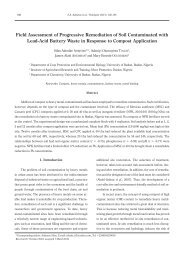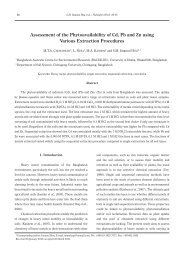Land Degradation and Pedological Processes in a Changing Climate
Land Degradation and Pedological Processes in a Changing Climate
Land Degradation and Pedological Processes in a Changing Climate
- No tags were found...
Create successful ePaper yourself
Turn your PDF publications into a flip-book with our unique Google optimized e-Paper software.
322R. Lal / Pedologist (2012) 315-325quality of degraded/desertified soils. The loss <strong>in</strong> productionis not only of immediate concern, but also has cumulativeeffects over time (Fig. 5).7. <strong>Climate</strong> Change <strong>and</strong> Pedospheric <strong>Processes</strong>Soils are affected by climate change. Thus, the importanceof <strong>in</strong>clud<strong>in</strong>g a soil evolution module <strong>in</strong> modelsfor predict<strong>in</strong>g future climate change is widely recognized(Montagne <strong>and</strong> Cornu, 2010). Soils affect climate changethrough emission of radiatively active gases (i.e., CO 2 ,CH 4 , N 2 O). Depletion of SOM, through biological degradation,exacerbates gaseous emissions <strong>in</strong>to the atmosphere.Increases <strong>in</strong> temperature due to global warm<strong>in</strong>g may accentuatethe rate of m<strong>in</strong>eralization of SOM, reduce aggregation<strong>and</strong> aggregate stability, <strong>and</strong> accelerate soil erosionrisks. An <strong>in</strong>crease <strong>in</strong> frequency of extreme events, large<strong>and</strong> <strong>in</strong>tense ra<strong>in</strong>s <strong>and</strong> high w<strong>in</strong>ds, can <strong>in</strong>crease climaticerosivity. Therefore, climate change may accentuateclimate erosivity while <strong>in</strong>creas<strong>in</strong>g soil erodibility. An <strong>in</strong>crease<strong>in</strong> evaporation can decrease available water capacity,reduce vegetation cover, <strong>and</strong> decrease the amount ofbiomass-C returned to the soil. Thaw<strong>in</strong>g of permafrost(cryosols) <strong>and</strong> dra<strong>in</strong>age of peat soils can create positivefeedback, accentuat<strong>in</strong>g the rate of m<strong>in</strong>eralization of SOM<strong>and</strong> further exacerbat<strong>in</strong>g climate change.Yet, restoration of degraded/desertified soils can <strong>in</strong>creasethe ecosystem C pool <strong>and</strong> off-set some anthropogenicemissions. The potential of C sequestration is estimatedat 0.2–0.7 Pg C/yr through desertification control,<strong>and</strong> 0.3–0.7 Pg C/yr through restoration of salt affectedsoils. In addition, adoption of RMPs can sequester 0.4–1.2Pg C/yr <strong>in</strong> cropl<strong>and</strong> soils, 0.3–0.5 Pg C/yr <strong>in</strong> grassl<strong>and</strong>/graz<strong>in</strong>g l<strong>and</strong> soils, <strong>and</strong> 1.4–1.9 Pg C/yr through afforestation/deforestation<strong>and</strong> the establishment of forest plantations.Thus, the total technical potential of C sequestration<strong>in</strong> the terrestrial biosphere is 2.55–4.96 Pg C/yr (Lal,2010).Thus, the threat of human-<strong>in</strong>duced climate changecreates challenges <strong>and</strong> opportunities. The challenge lies<strong>in</strong> the <strong>in</strong>creased risks of pedospheric l<strong>and</strong> degradation becauseof higher rates of depletion of SOM, acceleration <strong>in</strong>soil erosion, <strong>and</strong> high risks of sal<strong>in</strong>ization. Yet, there areopportunities to improve soil quality, <strong>and</strong> restore degradedsoils by sequestration of C <strong>in</strong> the terrestrial biosphere.The w<strong>in</strong>-w<strong>in</strong> option is important for restor<strong>in</strong>g degradedsoils, mitigat<strong>in</strong>g climate change, improv<strong>in</strong>g water quality<strong>and</strong> the environment, <strong>and</strong> advanc<strong>in</strong>g food security.8. Technological Options of Restor<strong>in</strong>g DegradedSoil <strong>and</strong> Desertified <strong>L<strong>and</strong></strong>sThe key strategy of revers<strong>in</strong>g the degradation spiral isrestoration of soil quality (Fig. 6). The goal is to conservewater <strong>and</strong> nutrients, <strong>in</strong>crease vegetation cover, <strong>and</strong> improvethe SOM pool. Soil quality is <strong>in</strong>deed an appropriate<strong>in</strong>dicator of susta<strong>in</strong>able l<strong>and</strong> management (Herrick, 2000),<strong>and</strong> the quantity <strong>and</strong> quality of the SOM pool are importantdeterm<strong>in</strong>ants of soil quality. There is a threshold levelof SOM concentration <strong>in</strong> the root zone (1.9–3.4%), whichdepends on climate, soil type, l<strong>and</strong>scape position, dra<strong>in</strong>age,<strong>and</strong> profile/solum depth. Rather than concentratedonly <strong>in</strong> the surface soil, deep SOM storage is also a keyfactor, but the processes govern<strong>in</strong>g deep SOM (sub-soilbelow 50 cm depth) placement <strong>and</strong> dynamics are poorlyunderstood (Lorenz <strong>and</strong> Lal, 2005; Rumpel <strong>and</strong> Kogel-Knabner, 2011).There are strong synergies between mitigation of <strong>and</strong> adaptationto climate change, especially <strong>in</strong> the context of agriculture(Smith <strong>and</strong> Oleson, 2010). Biotic sequestration ofatmospheric CO 2 has strong cost-effectiveness. Becauseof the strong <strong>in</strong>teraction between C <strong>and</strong> water (Evett <strong>and</strong>Tolk, 2009), <strong>and</strong> between C <strong>and</strong> N (Lal, 2010), the strategyis to adopt l<strong>and</strong> use <strong>and</strong> management practices whichaccentuate the use of efficient energy-based <strong>in</strong>put (fertilizers,irrigation, tillage), <strong>and</strong> create a positive C budget(Lal, 2010). Management of soil fertility, <strong>in</strong> conjunctionwith that of C <strong>and</strong> water, is an important factor, especiallyfor restor<strong>in</strong>g degraded soils managed by resource-poorfarmers through extractive farm<strong>in</strong>g practices <strong>in</strong> develop<strong>in</strong>gcountries. <strong>L<strong>and</strong></strong> application of organic by-products orco-products (misnomered as waste) is relevant to restor<strong>in</strong>gsoil ecosystem (Odlare et al., 2010). This strategy canbe adopted <strong>in</strong> conjunction with production of biofuels. Degraded/depletedsoils are prone to drought stress, havelow soil fertility, <strong>and</strong> are constra<strong>in</strong>ed by elemental imbalances(Al +3 toxicity). Such challenges of low soil fertility












